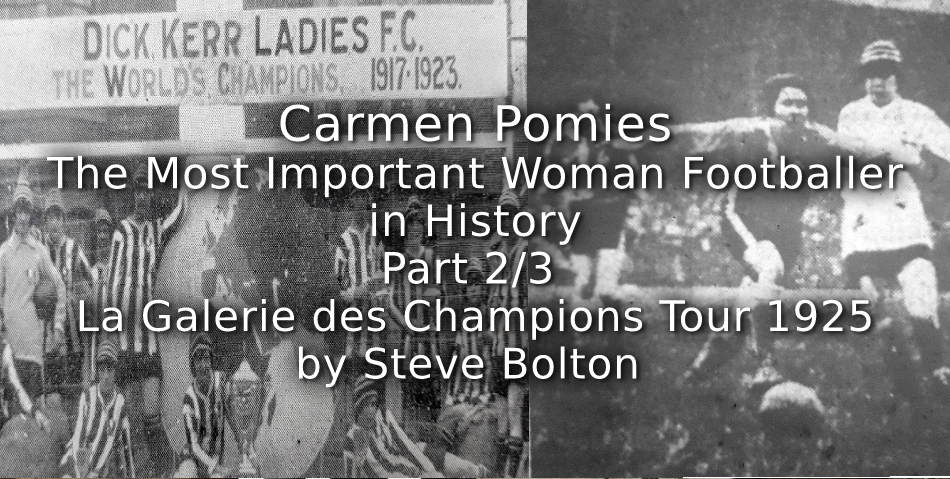To read Part 1 of this series click HERE

The Houses of Parliament, London
Source: Lizzy Ashcroft Collection
1925: Tea on the Terrace
On Monday 11th May 1925 my granny Lizzy Ashcroft would have been 20 years old. When she awoke on that morning in the Bonnington Hotel in Bloomsbury, London I cannot begin to think how excited she must have been. She was by then a regular in the Dick Kerr Ladies which now had goal scoring legend Florrie Redford as Captain and the irrepressible Lily Parr on the left wing. Lizzy and most of the Dick Kerr Ladies must have felt quite intimidated to have probably their one ‘going out’ outfit compared to their French counterparts who were mostly middle class and bringing the latest Paris fashions – Carmen, Mado, Therese, Ida, etc… The teams were to be given the rare honour for a women’s football team of a reception by the Lord Mayor of London. This was then to be followed by the unique honour from one of the founders of the British Legion, Member of Parliament Sir Jack Benn Brunel Cohen. La Galerie des Champions of Femina Sport and the Dick Kerr Ladies were to have afternoon tea on the House of Commons Terrace. They then had the small matter of a filmed football match at Herne Hill Velodrome later on in the evening…
1925: Granny Lizzy Ashcroft’s Opposition

Très Sport – La Galerie des Champions
Ida Rebardy, Carmen, Thérèse Brulé, Mado
Source: Lizzy Ashcroft Collection
Alfred Frankland: The Most Important Person in Women’s Football History
The fact that the Dick Kerr Ladies (albeit with a name change to Preston in 1926) survived for 48 years is an astonishing achievement. Logic would dictate I think that the most important person in women’s football history is a man: Alfred Frankland, manager of the Dick Kerr Ladies. The Dick Kerr Ladies would, I believe, have survived without any one of Lily Parr, Alice Kell, Florrie Redford and indeed Lizzy Ashcroft. No football team is above one player. In my opinion they would not have survived without Alfred Frankland and they would not have survived without Carmen Pomies. In Parts 2 and 3 of my article I will provide my reasoning for this belief. Alfred controlled and dealt with large sums of money over many years and there have been various claims made about how that money was used. I am not qualified to pronounce judgement in this area and I am setting aside any qualitative or quantitative analysis of this aspect. Regarding his contribution to the game Alfred was an organisational genius. He was hardworking and industrious. He was a showman in the mould of PT Barnum and it is obvious to me when he was and wasn’t involved with running the team. I have assumed for a long time that he was responsible for this amazing and ambitious tour in the middle of the ‘wilderness’ years, but I was wrong…
The Shipwrecked Mariners Society

The Shipwrecked Mariners Society
Source: Courtesy Shipwrecked Mariners Society
Nearly Two Centuries Helping Families in Need
The Shipwrecked Mariners Society is a very valuable modern charity and continues to provide financial assistance to fishermen, mariners and their dependants, something which they have done for 181 years. They provide key help to those who have suffered misfortune or poverty, as a result of an accident, illness, disability, unemployment or retirement. The Society runs on a model of a core of paid staff who coordinate the voluntary work of 170 Honorary Agents. In 1925 when a greater national proportion of employment came from maritime activity the Society had 13 paid staff and 1,000 voluntary Agents. They were in a constant battle to raise funds. Why then did the Society underwrite this particular tour in the middle of the ‘wilderness years’. One key factor is Cecil Kent of Westminster School who organised the tour. He was an influential man from a naval family and he passionately supported women’s football. However, it is worth looking at one particular game 4 years earlier just before the ban took place…
1921: An Important Blackpool Game (Pre-Ban)

Friday 15th June 1923 Dick Kerr Ladies Float in the Blackpool Carnival
Source: Courtesy Blackpool Council Heritage Service
Wednesday 21 September 1921: DKL 4 v 0 Wales
This was one of 67 games played by the Dick Kerr Ladies in 1921. The game was organised to aid the Shipwrecked Mariners Society and it was a high profile match. The Welsh team was selected from players from Cardiff, Swansea (Baldwin’s), Newport and Bargoed. Maud Langford, the Wales right half was 17 Years old. Despite some smart saves from the Welsh Goalkeeper Lamprey the Welsh team went in at half-time 1 – 0 down thanks to a Florrie Redford shot. According to Gail Newsham the eventual score was 4 – 0 with a Florrie Redford hat-trick and a Jenny Harris goal in front of a crowd of 12,000.* The referee was Mr R W Sharp of Blackpool. Quite a fuss was made in Blackpool. The Welsh team had a Mr W H Ferris managing them and a Mr T Mincher as trainer. The Welsh team travelled up the day before and were welcomed and entertained at Blackpool Town Hall by the Mayoress Mrs C W Callis. After the games both teams were ‘entertained’ at a Banquet by the proprietors of Blackpool Trocadero, Ltd. The Deputy Mayor, Councillor E H Howe presided over the banquet with Mr T Kensall of Blackpool FC present. Captain Fred Haworth represented the Shipwrecked Mariners Society. The Shipwrecked Mariners at the time had as their Chairman Admiral W F S Mann. However, after 18 years of tenure he retired one month later and Vice-Admiral A E A Grant was elected in his place. Captain Haworth reported that £482 had been raised for the Society. This was a very large sum of money in those days. This was one of the last of the big fundraising games on a professional FA associated ground before the ban was enacted. It is interesting to note that Admiral Grant was one of the dignitaries greeting the Galerie des Champions team at Victoria Station 4 years later. He would almost certainly have remembered this successful fundraising game just before his tenure began at the Shipwrecked Mariners Society. The other influential person would be Captain Fred Haworth and it is worth examining his role.
*The Shipwrecked Mariners Annual Report for 1921 Reports:
The weather was perfect, and some 8,000 spectators were present.
This is 4,000 fewer than reported by manager Alfred Frankland. Alfred Frankland was prone to overestimating crowds in his effort to brand and build the Dick Kerr Ladies legend. Whilst this helped build the brand and their survival it would gift the English FA a huge disparity in projected income from the women’s games and the amount actually donated. This missing money was one of the two key arguments which were used to enact the ban.
The accounts have not yet been completed, but the expenses will necessarily prove rather heavy, as they include insurance against bad weather, and the railway fares of the Welsh team, &c, but it is believed that a handsome amount will be handed over to the Society.
The Society’s Annual Report for 1921 states:
The most successful Flag Day was that held at Margate in September, realising £97, and a remarkable success attended a Ladies’ Football Match held at Blackpool in the same month, which yielded no less than £247.
Here is strong evidence that it was expensive to put on high profile women’s matches, they generated huge incomes for charity, and yet the women footballers were providing the ammunition for their enemies at the FA.
Captain Fred Haworth: Travelling Secretary of Shipwrecked Mariners Society
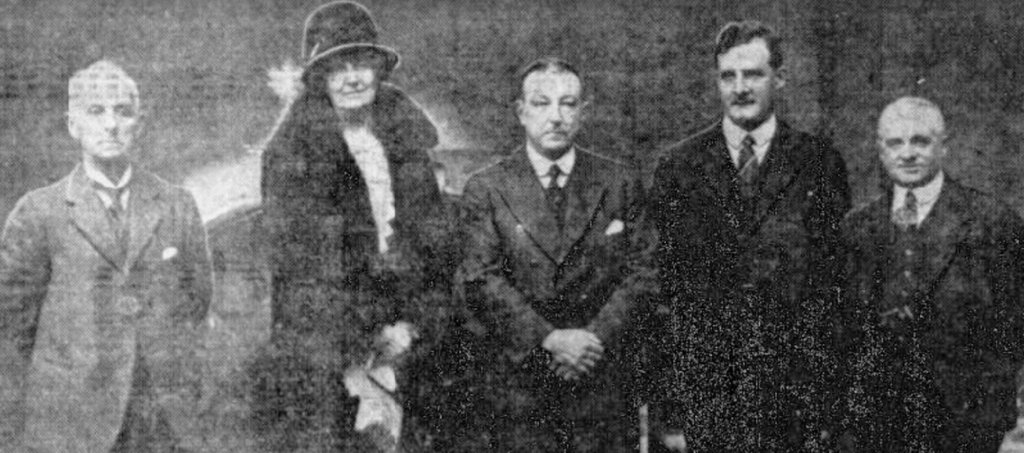
Surgeon Admiral McKeown, Lady Coates, Rear Admiral Gordon Campbell VC DSO, Lieut-Commander JRP Thompson, RN and Captain Fred Haworth at a Belfast City Hall Meeting of the Shipwrecked Mariners Society
Source: BNA Northern Whig Tuesday 3 December 1929
An Important Role
Captain Fred Haworth could be described as someone who had ‘saltwater in his blood’. He was a sea-captain with 30 years of sea experience from the end of the last century. One of his tasks was to go around the country giving talks about the role of the society. He was able to enliven these talks with stories of his adventures from 30 years at sea. He was quite simply the Society’s ‘face’ and representative whenever and wherever needed. This could be anything from a talk to rotarians in Coventry to presenting flowers at the end of a fundraising opera in Belfast. He was very highly trusted because there was a huge financial aspect to his role. When a disaster occurred the voluntary agents would act and provide aid. He gives one example in one of his talks where a crew of 24 were rescued with great difficulty after spending several days drifting at sea. The honorary agent of the Society gave them hot drinks, warm clothes and warm beds. Money that was advanced in great need was expected to be paid back when conditions allowed and monitoring and encouraging this repayment was part of his job. It is interesting to note that he was on duty during the 1921 Blackpool match and so he would have been very supportive of the 1925 tour. His job on the tour was not only to give speeches and represent the Society. He was also there to make sure that the finances were handled appropriately and that the Society maximised its income.
La Galerie des Champions 10 Game Tour

Source: Author
Organising a Women’s Football Tour 4 Years After the BAN
There are several points which I think would inform thinking about this tour. Despite the fact that the written evidence states that the tour was organised by Cecil Kent, the Dick Kerr Ladies manager Alfred Frankland would have had a key role in the organisation. The locations of the games have always been a puzzle to me. Mellor, for instance, is a village 3 miles from Blackburn with a current population of just over 2,000. One very noticeable omission is a game or an official reception in Preston itself. The last high profile game in Preston was played on 25th March 1922 against Olympique de Paris at Ashton Park (Dick Kerr’s Sports Ground). The next high profile match in Preston for the DKL was on 1 August 1932 on Moor Park. (This was a very special and important game which I will cover in detail in Part 3). I think it would be reasonable to surmise that ‘officialdom’ had turned against its own in Preston which is rather sad. I think that 5 of the games were key games which were planned well in advance. I think the rest were ‘fillers in’ arranged possibly quite late in the day. The first Herne Hill game was obviously the starting point of the entire tour. Given the lack of support in Preston the game at Padiham (4 miles from Burnley) makes sense as the big ‘home’ game. Burnley newspapers were generally very supportive of women’s football in that era. The Manchester game at Fallowfield athletic track makes sense as the big first ‘Saturday’ game in the tour. The DKL had long standing connections with Dumfries (see my Scottish articles with Dr Fiona Skillen – references at the end) and this would make sense to be in place to catch the ferry for the other big game of the tour on the second Saturday in Belfast. In the rest of this article I will provide further evidence to support my suppositions.
This was also a very physically demanding tour. There are very few rest days and the active days were filled with activity apart from football. The two teams were obviously kept to a minimum because of the costs involved but the inevitable injuries would have been a problem. At only the third game in Mellor Maria-Therese Thierry received a rather nasty face wound and had to have several stitches applied by a doctor. The games were very close. If we remove the last two games where I imagine that the French team were simply exhausted we see a pattern of extremely close and exciting games. The results were 5 wins for the DKL, two draws and a loss. Newspaper reports suggest that some of these games could have gone either way.
Game 1: Herne Hill Velodrome

Herne Hill Velodrome
Source: Lizzy Ashcroft Collection
Game 1: DKL 4 – 2 Femina Sport
Herne Hill Velodrome is a rare and beautiful treasure. It has been the home of British Cycling since 1891. The entrance on Burbage Road is tucked away (like someone has removed their garage!) amongst the £2.5 million houses of Dulwich, London. Despite its association with cycling the arena had a football pitch and during WW1 Crystal Palace used the pitch as their home ground. There is also a clip of a mixed charity football match played on Saturday 2 November 1918 at Herne Hill. The clip is titled: “Girls Beat Police at Football”. The famous Vickers (Crayford) Ladies FC took on L-Division Police in a rather comedic game for charity. The iconic pillars of the original stadium were reused when the new stadium was rebuilt and these can be seen very clearly on the video clip.
The match was seen by a crowd of 6,000*. DKL were playing in their ‘international’ strip of white jerseys with black and white shorts and black and white woolen bobble hats (minus bobble). Femina Sport played in marine blue tops with white edging and black shorts with a white stripe. Most of the french team were wearing black berets although Carmen has discarded hers for the kick-off. Although the DKL lined up with hats on by the end of the game only a few players from both teams were wearing their headgear. Lily Parr scored 2 goals, Lily Lee and Lily Buxton one each and playing a captain’s role Carmen scored both goals for Femina.
*Two different reports of crowd size seem to have ‘gone out on the wire’: 6,000 and 3,000. I have visited the arena and spoken to the management about this point. I have also looked at the pictures and footage and I estimate the 6,000 figure to be more accurate. This is obviously just my estimation.
Sir George Edward Wade, CBE (George Robey)

Celebrities Backing Women’s Football
George Wade (known professionally as George Robey) was a giant of music hall and theatre with a stage career that lasted from 1890 to 1950. In May of 1925 the ‘Prime Minister of Mirth’ as he was known was appearing in a long running revue at the London Palladium called “Sky High”. The picture above is from the rather racey sketch in the revue where it is implied that the married woman played by actress Marie Blanche is in George’s private rooms wearing only a cloak. Interestingly, when the revue transferred to Birmingham the sketch was felt to be too much for the good folk of Birmingham and the authorities insisted upon it being considerably altered. George supported the war effort during WW2 so he would have been disposed to the charitable nature of women’s football. He also took quite an effort to get to and from the ground as it was reported that he was half an hour late for his performance that night, due to his vehicle having difficulties getting out of the ground because of the large crowd. This may be further evidence that the crowd was 6,000 and not 3,000. It is also further evidence of just how important this game was.
Battle of the Fashions! Courtyard of the Bull & Royal Hotel, Preston

Eugène Janvier, Mado, Couval, Chatelot, Maria Charbonnel, Gemaine Thomas, Droward, Thérèse Brûle, Thérèse Renaud
Helene Gillot, Maria-Therese Henry, Lucille Gillot, Carmen, Ida, Dessard, Elsie Depeuch
Source: BNA LEP Monday 18 May 1925
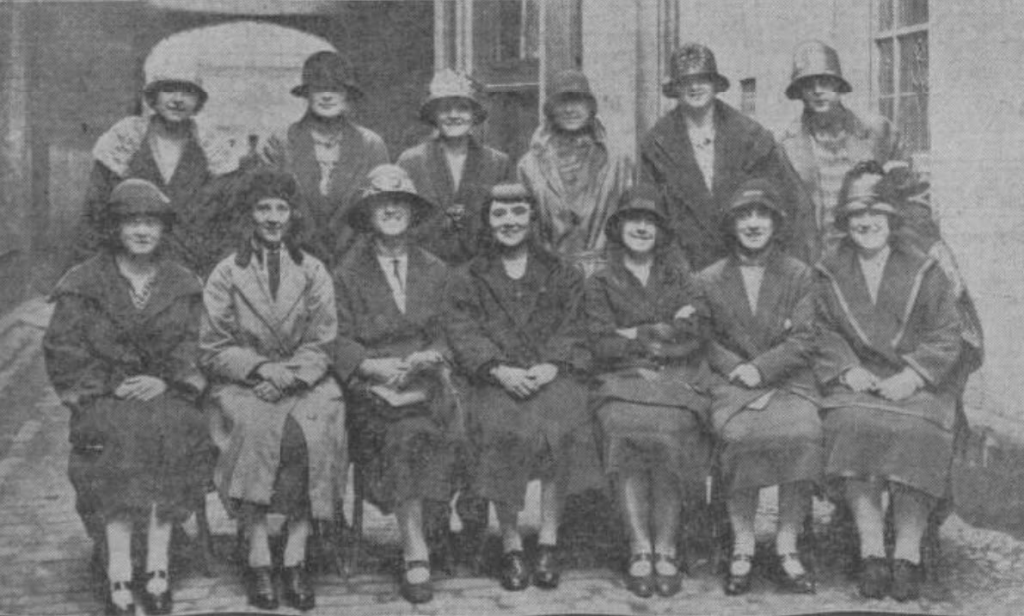
Annie Crozier, Lily Martin, Lily Lee, Florrie Redford, Lizzy Ashcroft, Lily Parr
Maggie Shaw, Polly Scott, Lily Buxton, Jenny Harris, Lydia Ackers, Hilda Parkinson, Jenny Lancaster
Source: BNA LEP Saturday 16 May 1925
The Bull and Royal Hotel, Preston

Bull and Royal Hotel Derby Ballroom, Preston
Source: Lizzy Ashcroft Collection
A Beautiful Hotel and Architectural Gem
The Bull and Royal Hotel is currently a popular Preston Public House. The Hotel can trace its history back to the sixteenth century and is worthy of a blog article on its own. In 1925 it was Preston’s finest hotel and it was located at the very epi-centre of town with Preston’s tram system starting its main routes from just outside the front of the hotel. The above picture shows the splendid architecture of the sprung-floor Derby Ballroom which is now used as a store. The pictures above showing the two teams posing in Courtyard of the Bull and Royal Hotel are very interesting. My 5 foot 8 inch (173 cm) granny is standing next to Lily Parr who is standing next to the window. Look at the picture of the Dick Kerr Ladies with this thought in mind and then look at Therese Renaud in the Femina picture. One of my favourite things to do when I visit my home town of Preston is to wander through that courtyard, stand by the window and sample one of the beverages on offer at the Bull and Royal. I know that I am standing in the place occupied by some very special footballers. And I love Mado’s hat…
Game 2: Padiham (The ‘Home’ Game)
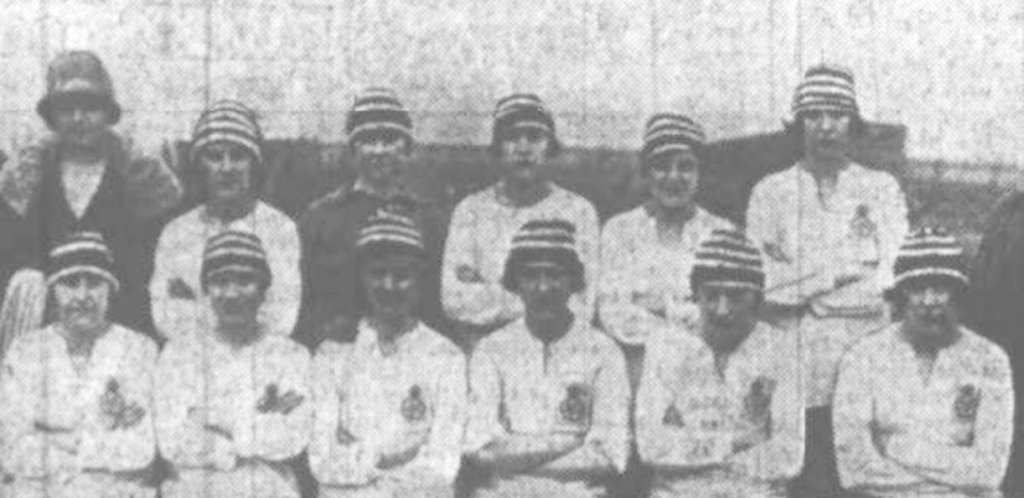
Right Side – Lizzy Ashcroft (standing) Lily Parr (sitting)
Source: BNA Burnley Express Saturday 16 May
Game 2: DKL 3 – 2 Femina Sport
After spending Sunday and Monday nights at the Bonnington Hotel in Bloomsbury, London the two teams would have been up early on Tuesday 12th May to catch the direct 4 hour train from London Euston to Preston Station. The French team would have checked into their hotel which is a short walk or taxi ride from the Station. Unlike previous tours there were no cheering crowds to welcome the teams into Preston. The fact that it would have been around the middle of the day on a Tuesday may have had some bearing on this, but it may have given everyone the idea that this tour was not to be as successful financially as had been hoped.
The teams would have had little time to rest as they were due to play in Padiham which is a good 30 minute drive to the other side of Blackburn. Padiham’s male football team ceased existence during WW1 and was not resurrected until 1949. This fact may help explain the local enthusiasm for a women’s ‘international’ football match. It also might go some way to explaining why there was a decent ground available to host the game. The other factor which played a large part in this tour was the weather. The archives of the Shipwrecked Mariners Society quote: “… it is melancholy to relate that our English May weather, as not infrequently the case, was unpropitious and that, out of the 10 matches, 5 were seriously affected by rain.” In a detailed article the Burnley Express noted that this game suffered from rain. The teams were welcomed to Padiham by large crowds on the streets, but only a small crowd of 3,000 actually witnessed the game. The rain affected the game which caused a greasy playing surface and frequent tumbles. The paper points out that the French team were at a disadvantage physically and so needed to outskill their opponents. Scoring was initiated by Femina with a ‘clever goal’ initiated by Carmen. Lily Parr replied with a penalty given for an obvious trip. The second Femina goal was scored by Carmen: “Mlle Pomies showed fine anticipation when she brought a neat centre under control a yard or two out, and gave the goalkeeper no chance of saving a hard drive.” The DKL levelled the scores just before half time from a breakaway run. At the start of the second half Femina conceded a ‘disastrous’ early goal and despite being described as being the better team were unable to break down the ‘sturdy and resolute defensive tactics’ of the Dick Kerr Ladies. The ‘gate’ was estimated at £70 to £80 which given the considerable overheads of the tour was not good.
The two teams were entertained in the evening at Padiham Liberal Club. The teams and the charitable work of the Dick Kerr Ladies were praised. Many toasts were given such as: “Peace and Prosperity to the Great French Republic.” When Captain Fred Haworth of the Shipwrecked Mariners gave his speech it is interesting to note whom he thanked. Councillor Coe Chairman and the ‘indefatigable’ committee of the Liberal Club were the first to be thanked. Mr Gee was thanked next for letting the ground. The next to be thanked are the Band, the ambulance and all the other helpers. It is evident that even just putting on one game was a challenge and a huge exercise in logistics.
Game 3: Mellor

Dick, Kerr’s (English Electric) Factory – Strand Road, Preston
Source: Lizzy Ashcroft Collection
Game 3: DKL 4 – 1 Femina Sport
Wednesday 13 May appears to have been a rare and welcome rest day for the teams. Their next fixture was the following day at Mellor. Early in the first half Maria-Therese Thierry went for a header and met the boot of one of the DKL. She had to have several stitches and was hors-de-combat for the rest of the game. There was no substitute so the match was won quite easily by the Dick Kerr Ladies who were leading by three goals to nil at half-time.
The following day, Friday 15th May the two teams were given a reception at the Dick, Kerr’s Factory canteen on Strand Road. (Dick, Kerr’s was now owned by English Electric.) The Mayor of Preston Alderman JR Hodgson welcomed the French team. There were the usual speeches and then the Dick, Kerr’s band performed. The Mayor was lucky enough to dance with several members of the French Team. The Lancashire Evening Post did not record whether he danced with any of the English Players!
Author’s Note
One half of the Dick, Kerr’s Factory is still there on Strand Road. Thanks to the remarkable work of Gail Newsham its beautiful blue Plaque which celebrates the famous team adorns this Preston landmark. The building has tremendous resonance for me because not only did my granny play for the Dick Kerr Ladies, my other grandad worked at the Dick, Kerr’s Factory as a turner. Just along the same road is the home of Preston Sea Scouts. This wooden building is part of the original Moor Park Hospital from WW1 which was the reason the Dick Kerr Ladies were started originally. If you place your camera to the window of the factory with flash on, as well as getting some funny looks from the queuing traffic you can get a great shot of the interior of the factory…
Game 4: Manchester Athletic Club, Fallowfield

Manchester Paper Reporting a 9 Game Tour…
NB Kilmarnock (two)
Source: BNA Athletic News Monday 11 May
Game 4: DKL 2 – 2 Femina Sport
The Manchester Athletic Club Stadium or MAC as it was known was in the Fallowfield District of Manchester. The Fallowfield stadium was originally opened in May 1892 as the home of the Manchester Athletics Club. It remained primarily as an athletics stadium for most of its lifetime but also featured a number of other sports. Most famously the FA Cup Final was held there in 1893. In 1994 the owners of the stadium, Manchester University had it demolished to be replaced by student halls of residence. It hosted a number of high profile women’s football games after the FA Ban as the stadium was not under the control of the FA.
The Belfast Newsletter reported a crowd of 10,000 for this game. Gate receipts were reported of £250 so there was certainly a decent crowd. The brief newspaper articles also stated that the reason the French were able to give the Dick Kerr Ladies a good game was that they were not as good as they used to be. Femina opened the scoring on this occasion with a Germaine Thomas goal. Lydia Ackers equalised and then just before half-time Florrie Redford added to her immense lifetime tally of goals. In the second half Captain Carmen Pomies missed a penalty but made amends by scoring ‘a splendid goal’. It appears as if this game should really have been a win for Femina Sport.
Blackpool Je T’Aime…

Teams & Dignitaries – Town Hall Steps – Blackpool
Source: Blackpool Gazette
Blackpool Rolls Out the Red Carpet & Femina Sing La Marseillaise
After another rare day off on the Sunday the teams had a full day visit to Blackpool on Monday 18th May. A tricolour festooned coach picked the teams up from the Bull and Royal Hotel in Preston and made the 20 mile drive to Blackpool. It must have made quite a show. The teams were afforded a Civic Reception and in the picture above the teams are seated with the Mayor Councillor Thomas Pilling Fletcher, Mayoress Fletcher and ex-Mayoress Mrs Howe (wife of ex-Mayor Eli Hey Howe). Blackpool’s Olympic Champion swimmer Lucy Morton was also present. Two corporation omnibuses were then provided for them to drive along the Promenade to visit the open air baths at South Shore. The Mayor gave a popular speech where he quipped that France had lost a million and a half men during the war, “and was it surprising therefore, that the women of France now sought to replace those in the realms of sport?” In the evening the teams visited the Winter Gardens and were impressed by the Empress Ballroom. The Femina Sport team lined up beneath the orchestra and gave a spirited rendition of ‘La Marseillaise’ for which they received tumultuous applause from the large audience in the ballroom. The next day Tuesday 19th May in Hyde, Manchester resulted in a 2 – 1 win for Femina and rather frustratingly I have not been able to locate any match reports to date…
Game 6: Kilmarnock, Scotland

Advert for Kilmarnock Game
Source: BNA Kilmarnock & North Ayrshire Gazette Friday 15 May
Game 6: DKL 2 – 1 Femina Sport
On Wednesday 20th May the teams played a close fought game at Kilmarnock’s Ground, Rugby Park. The reported attendance was 2,000. Provost Wilson kicked off and the Kilmarnock Band gave a musical programme during the game. The Kilmarnock and North Ayrshire Gazette describe Carmen Pomies as a ‘typical Parisian girl athlete, fond of all outdoor sports. Florrie Redford is described as a ‘prolific goal-scorer’. Lily Parr is described as ‘a really amazing player and would undoubtedly be playing First League if the English football legislators would allow it’. Polly Scott was described as ‘the girl McCracken by her knowledge of the offside rule. This is a reference to the male Northern Irish international footballer Bill McCracken who was famous for inventing the offside rule. Polly Scott played originally for Chorley and then for Fleetwood Ladies FC. (Dr Alex Jackson has written a series of articles about Polly and the Fleetwood Ladies – reference at the end of this article). Interestingly she is described as being an ex-Dumfries player. The Dick Kerr Ladies were described as being the ‘heftier’ lot. Despite praise for the French Goalkeeper Femina were trailing 2 – 0 at half-time. In the second half Femina managed to score and miss a penalty. So this game should probably have been a draw. It is interesting to note that this game was not subject to sanction from the Scottish FA and yet the game the following day was subject to strict sanction. The Athletic News was reporting on May 11th that the two Scottish games were to be played in Kilmarnock. One factor that may be of note is that there previously had been an English Electric Factory in Kilmarnock. However, a ground was found and the second game in Scotland did take place in Dumfries.
Game 7: Dumfries, Scotland

Women’s Football in Scotland was not Formally Banned until 1947
Source: BNA The Scotsman Thursday 12 March 1925
Game 7: DKL 1 – 1 Femina Sport
Following their close game on Wednesday at Kilmarnock the teams were able to secure a pitch at Balmoral Park, Dumfries. Palmerston Park, the home of Queen of the South was made unavailable to them as can be seen. Notice that the warning was issued in March. Nevertheless a crowd of 2,000 turned up to watch a close and exciting game. Captain Carmen Pomies went in goal and was pivotal in her side securing a draw. The Dumfries Standard (my thanks to Stuart Gibbs) even went as far as saying:
In goal Mlle Carmen Pomies, the Captain of the French team, and whose usual position is at centre half, saved again and again in the most approved style. Mlle Pomies is acclaimed the finest lady athlete in France, champion javelin thrower of Paris, and all-round sportswoman, equally expert at tennis, hockey and rugby. She stood up to the English attacks in the most confident fashion and the way she clutched and cleared the ball would have done credit to a First League ‘keeper.
Lily Lee scored the first goal from a well directed 15 yard shot in the first half. In the second half the Dumfries Standard reported:
The French girls were now well led by Mlle Madeleine Bracquemond, their sharp-shooting centre-forward, and the English defence was sorely troubled by the frequent raids.” “…and five minutes from the end Mlle Bracquemond equalised with an exceedingly smartly taken goal.
In the last minute Lily Buxton broke clean through but was thwarted by ‘the amazing Mlle Pomies clutched and held the ball in safe hands’.
A Belfast Welcome…
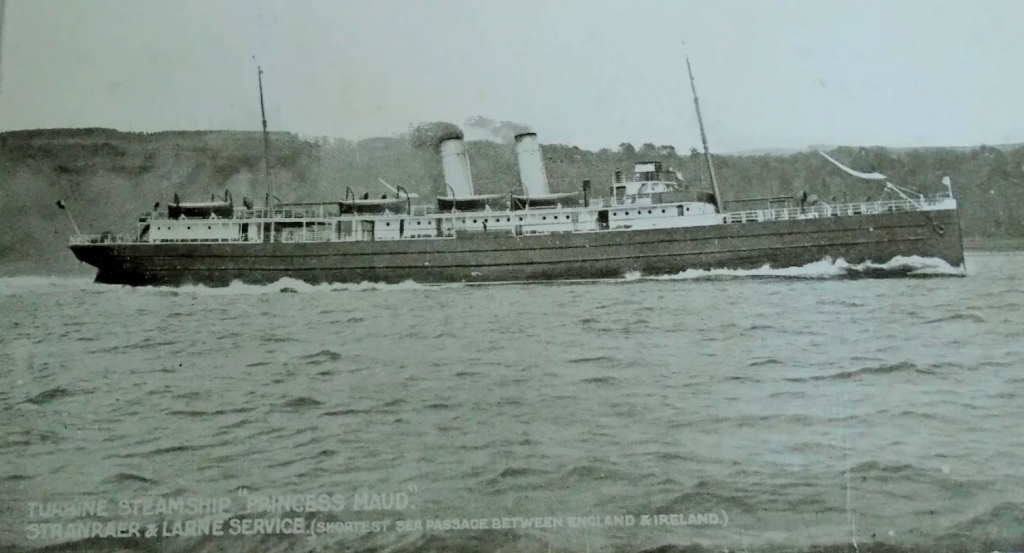
Turbine Steamship Princess Maud
Source: Lizzy Ashcroft Collection
Friday 22 May: Another Busy Day
It is worth another look at this part of the teams’ itinerary:
Monday – Long day in Blackpool
Tuesday – Game in Manchester
Wednesday – Travel to Kilmarnock, check into hotel and very close game
Thursday – Travel to Dumfries and another very close game
The teams must have been very tired. Nevertheless, on Friday 22nd May they would have had another early start to catch the short 2 hour ferry crossing from Stranraer to Larne on the Princess Maud steamship. The teams were welcomed at Belfast’s Midland Rail Station by the Lord Mayor Sir William Turner JP and Sir Robert Baird the founder and proprietor of the Belfast Telegraph newspaper. Diana Scott the celebrated Belfast Charity Fundraiser and women’s football organiser took a large part in organising this part of the tour and she was also there to welcome the teams. (Dr Alex Jackson has written a series of articles about Diana Scott – reference at the end of this article). The teams were motored to their hotel and after a quick freshen up they were the guests of Mr and Mrs H L Garrett at Dunville’s on Arthur Street. Dunvilles Whiskey was a famous brand of spirit. They also visited the massive Gallahers cigarette factory and then attended the first house of the Belfast Hippodrome. This must have been an enjoyable but very tiring day.
Game 8: Windsor Park, Belfast

Carmen Pomies in Full Flight
Source: BNA Belfast Telegraph Monday 25 May 1925
Game 8: DKL 2 – 0 Femina Sport
This game was kicked off at 3.30pm by the Lady Mayoress on Saturday 23rd May at Windsor Park. Windsor Park at the time was owned by Linfield Football Club, one of the professional teams in Belfast. The Belfast teams were generally very supportive of women’s football. There was no Irish FA ban and Linfield in particular famously ‘signed’ Sadie Smith of Rutherglen in 1927. I attempted a rough calculation based upon the gate figures and would estimate a crowd of about 2,500. This is a ‘good’ crowd but nowhere near the size of the crowds before the English FA Ban. It was noted that the French team were ‘thoroughly tired before the final whistle’. Ida Rebardy was singled out for praise and was ‘responsible for many clever saves’. Florrie Redford scored a ‘fine goal’ by shooting from a difficult angle. The Belfast Newsletter reported that: “Mlle Rebardy saved cleverly twice in succession, and later came out and threw herself at the feet of Miss Ackers when Miss Redford got across a good centre.” “Mlle Rebardy kept goal brilliantly”. Lily Parr scored from a penalty.
After the match the teams were ‘entertained’ at Ye Olde Castle Restaurant by the Lady Mayoress. There were numerous speeches and toasts. Two of the toasts were “The King” and “The President of the French Republic”. Carmen who spoke four languages fluently spoke in English and then in French proposing a toast: “The Winning Team”. These are confident, refined women mixing with the very top of society with ease and grace. As Cecil Kent so vividly put it in his poetic letter, when the ‘mutual admiration society’ had sated itself the players were able to get on the dance floor of the Ballroom and have a good boogie. It is interesting to note that the gate receipts were £436. The Northern Whig reported that after the payment of all expenses in connection with the game there remained the net sum of £279. In a clever move by Mr Walter and Mrs Diana Scott the Shipwrecked Mariners had agreed to split the outcome. The Royal Victoria Hospital, the Mater Hospital and the Ulster Hospital for Women and Children received £50 each. The remaining £129 went to the Shipwrecked Mariners Society. Remember, Captain Fred Haworth was on hand through the entire tour to ensure that the finances were properly managed. I personally find it very interesting that the expenses are accounting for 45% of the money generated by the gate. This is not something that I have seen despite a number of books about the history of women’s football. I think that this is worthy of further academic research.
Game 9: Chorley, Lancashire

Chorley Game – Some Statistics
Source: BNA LEP Tuesday 26 May 1925
Game 9: DKL 6 – 3 Femina Sport
The match report above for Monday 25 May I think begins to show the tiredness of the French Team in particular. With due respect to the good folk of Chorley (where I was born!) the Yarrow Football Ground is not one of the iconic footballing venues which most people would recognise. The serious point that I am trying to make here is that after the high points of London, Manchester, Scotland, Belfast it may have been difficult to give this game their all. Notice that Carmen scored one and Mado scored a brace. Femina were still giving it their best shot but I suspect they just didn’t quite have the same stamina as the ‘heftier’ Lancashire lasses. The French team had now been touring for 16 days continuously. I have made the point before and I will emphasise the point again. There had been no tour previously that was remotely as ambitious as this one and there would not be another one. The 1,500 souls who paid their shilling to watch this game were participating in a very special piece of women’s sporting history.
Game 10: Herne Hill Velodrome, London

Herne Hill Velodrome Open Day
Source: Lizzy Ashcroft Collection
Game 10: DKL 6 – 0 Femina Sport – A Game Too Far?
I am fairly certain that this game was tacked on at the end to try to maximise income from the tour. Despite Admiral Sir Drury Wake kicking off this game attracted little media attention. The Shipwrecked Mariners Society Quarterly Statement points out this game was the worst affected of the 5 games by bad weather. It was also held on horse racing’s Derby Day so the crowd was not good. There are no detailed match reports but I think by now on their 18th day away from home the Femina Sport team could be forgiven for not being at their best. I think it is worth noting that in modern society we have got used to traveling (pre-Covid!) but in the 1920s travel for single women of this nature was very, very unusual. I would imagine that the French team who were mostly quite young would have been quite homesick by now. A simple thing like diet begins to wear after a while. I love my Lancashire food of butter pies and black pudding but I would imagine that Carmen, Mado and mates were quite relieved to be back in their beloved Paris.
Conclusion to Part 2

The Irish Free State
Source: BNA Northern Whig Monday 1 June 1925
Modern Assumptions
I think one has to be a little careful in analysing the article above. Everything in this part of the United Kingdom was very politicised including the press. It is a matter of record that despite their best efforts Carmen, Florrie and their teams never achieved their aim of playing in the Republic. This remarkable achievement was to fall two years later to the fabulous James H Kelly and his Rutherglen/ Molly Seaton Xl’s. If Carmen Pomies were to have retired at this point then I would not have provided evidence for my rather bold claims. The key to her importance comes when this tour has finished and we enter the real doldrums of the late 1920s before the renaissance of the 1930s. This tour was very, very important in sowing the seeds of what happened in the 1930s. To finish I would like to quote that passionate supporter of women’s football Cecil Kent of Westminster School:
Are Their Feet heavier on the Turf than the Men’s Feet?
Article © of Steve Bolton
Acknowledgements
My thanks to Gail Newsham without whose pioneering work this article would not be possible. For women’s football on the Continent I recommend the work of Helge Faller. My thanks to Dr Fiona Skillen for her support in writing this article.
In particular I would like to thank Sylvia White at the Shipwrecked Mariners Society who has provided insightful documentation from their archives. The Archive team at Westminster School have been similarly helpful and reading copies of their school magazine “The Elizabethan” from that era has been fascinating and has really helped to build a picture of the life of Cecil Kent. My thanks to Elizabeth and Bethany.
Dr Alex Jackson of the English National Football Museum in Manchester has written extensive articles on Playing Pasts about the Fleetwood Ladies (Polly Scott) and Pioneer of women’s football in Ireland Diana Scott.
Further Reading
Article on Playing Pasts – Author Steve Bolton
Article on Playing Pasts – Author Steve Bolton
Article on Playing Pasts – Authors Dr Fiona Skillen + Steve Bolton
Women’s Football in Interwar Scotland:Sadie Smith and the Legendary Rutherglen Ladies FCPar

